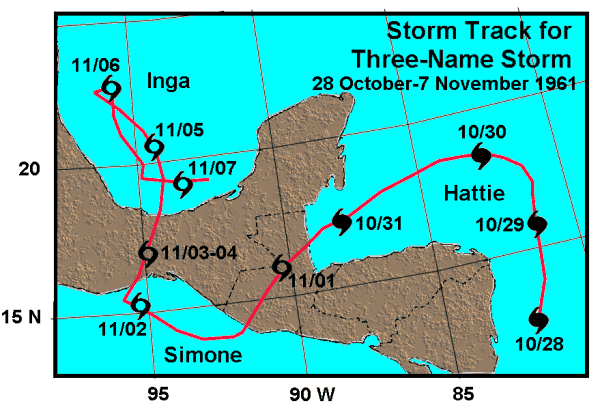 |
 |
| Home | Welcome | What's New | Site Map | Glossary | Weather Doctor Amazon Store | Book Store | Accolades | Email Us |
 | |||||||||
The Hurricane with Three NamesSomeone must have spoken too soon. As August 1961 ended, only one tropical storm had arisen that year on Atlantic waters: Hurricane Anna, a short-lived, Category-3 storm that raced from its birth waters southeast of the Lesser Antilles toward British Honduras (now Belize) from July 20 to 24. It looked like a yawner of a year, but it soon proved just a late bloomer. In the ten weeks from September 1, eight hurricanes developed, including two whose names would later be retired in infamy: Carla and Hattie. Hurricane Carla had the stronger winds, a Category-5 storm — the seventh strongest in US history — and caused the most monetary damage, $400 million in current dollars, but Hurricane Hattie became a killer storm taking 275 lives, most of them dying near the British Honduras capital, Belize City. As is common with the infamous, Hurricane Hattie, took on two aliases — Simone and Inga — after its deadly trek before dying quietly in the Bay of Campeche off eastern Mexico. Hattie came late in the hurricane season, the last of 1961, properly organizing as a storm on October 25 in the waters off Panama. As the tropical storm drifted northward, it rapidly grew in strength, becoming a hurricane in the late evening of October 27. Hurricane Hattie took initial aim on Cuba, but as she passed offshore of the Honduras–Nicaragua border late on the 29th, Hattie banked back to the west. Now a Category-4 storm packing 212 km/h (132 mph) winds, it moved into the Gulf of Honduras during October 30th.  Storm Track of 1961 Hurricane Hattie, Tropical Storm Simone and Tropical Storm IngaOn Halloween, Hurricane Hattie's winds reached 260 km/h (160 mph) with central pressure at 92.0 kPa (920 mb). Now a Category-5 storm, its track took dead aim on the British colony of British Honduras — today the independent nation of Belize. Halloween 1961 would bring no treats. As Hattie struck the coast from midnight to 3 am, the winds wailed at 260 km/h (160 mph) with gusts to 320 km/h (200 mph), pushing a storm surge of 4.0-4.6 metres (13-15 feet) above tide level. The first to feel its destructive force was the village of Calabash Caye on Turneffe Atoll. The village and most of its nearly 300 residents vanished. Next, Belize City took the storm fury. When the winds abated, forty percent of the city's buildings were destroyed and another thirty-five percent severely damaged. The human toll was also great. An estimated 200 had been killed, and thousands wandered the streets, digging in the ruins for food. The devastation of Belize City was so complete, nearly $50 million in damage, the capital was moved inland to Belmopan in the aftermath.  Belize City during and after Hurricane Hattie, 31 October 1961The battle between storm and land took much of the steam out of Hattie, and by late afternoon of the 31st, Hattie was downgraded to a tropical storm slipping over Guatemala. Down, but not yet out. As the storm continued westward, it crossed Central America and emerged in the new month in the western Pacific Ocean, the Gulf of Tehautepec. After half a day as a tropical depression, Hattie regained storm strength in the Gulf's waters and was renamed Tropical Storm Simone by the San Francisco Weather Bureau office. Tropical Storm Simone moved briefly westward, then on November 2 took a northerly turn toward Saline Cruz, Mexico. Now over the Isthmus of Tehuantepec (Mexico) and a tropical depression again, Simone headed back toward the Gulf of Mexico. The rugged, mountainous terrain of the isthmus halted the storm's progress and weakened it considerably, winds dropping to a mere 50 km/h (30 mph). As the depression moved over the warm waters of the Bay of Campeche around noon, November 3, it began to reorganize and deepen. On the evening of November 4, the new storm reached tropical strength and was named Inga, the last Atlantic storm of the 1961 season. Tropical Storm Inga strengthen to wind speeds of 115 km/h (70 mph) as it moved first northward, then southward off the Mexican coast between Veracruz and Tampico. During its last few days, Inga flirted briefly with hurricane force, but its rising pressure signalled the end was near. The killer that had been Hattie, finally dissipated for good during the morning of November 8. But was Inga still Hattie? Like the mystery of Jesse James, Hattie has raised some questions with its historic re-analysis. According to Darryl Randerson of Texas A & M University writing in the August 1963 issue of Weatherwise, Hattie–Simone–Inga was one storm that moved from Atlantic to Pacific and then back to the Atlantic basin. However, recent analysis of the data by Dr Chris Landsea, et al., at NOAA's Hurricane Research Division link Hattie with Simone, but do not include Inga as the same storm. Was Inga a reincarnation of Hattie or Hattie's offspring? Those few days over the Isthmus of Tehuantepec may hold the key as Simone lost its organization in the Southern Sierra Madre Mountains. Note: Since this was written, reanalysis of the data suggests, as reported by Chris Landsea that "there is no evidence that a single center of circulation persisted through [the]several crossings of land, but the envelope of moisture and instability from one system [Simone] helped spawn the next [Inga]."Learn More About Hurricanes From These Relevant Books
|
|||||||||
 |
To Purchase Notecard, |
Now Available! Order Today! | |
 |
 |
NEW! Now Available in the US! |
The BC Weather Book: |


